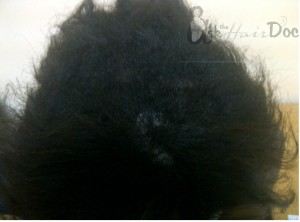
The Hair Follicle is composed of four functional zones: The Hair Bulb, Suprabulbar Region, Isthmus and Infundibulum. It originates deep down in the dermis or subcutaneous tissue.
The Hair Bulb
This is the section of the hair follicle from which the hair shaft is developed. It consists of the Hair matrix cells, as well as melanocytes, (pigment forming cells), which surround the Dermal Papilla. The Dermal Papilla contains all the blood vessels which carry the essential nutrients feeding the hair bulb. The matrix cells differentiate to become the different layers of the hair shaft, namely the cortex, medulla, and cuticle. Those forming the hair cortex become further compacted forming hard keratin at a higher level. The matrix cells also form the Inner Root Sheath which interlock with the outer layers of the cuticle forming a tight seal when the hair grows. The melanocytes produce melanin, (hair colour) which are incorporated into the developing cortical cells.
The Inner Root Sheath lies just outside of the outermost layer of the cuticle. It is composed of three layers- Cuticle, Huxley and Henle. The IRS cuticle interacts with the cuticle of the hair shaft. The Huxley layer is just composed of cuboidal cells. The Henle layer is composed of more elongated cells which start the process of keratinisation.
The Outer Root Sheath is also called the Trichelemma. It is separated from the IRS by the companion layer which allows the IRS to slide upward over the ORS during hair growth. It is covered by the Hyaline or Vitreous layer which is continuous with the basement membrane surrounding the dermal papilla. Both the IRS and ORS are responsible for moulding the hair shaft as it migrates from the skin.
Suprabulbar Region
It is also called the Lower Follicle. It lies above the bulb and below the isthmus. The Huxley and Henle layers become more prominent and keratinisation is in full swing at this point.
Isthmus
It is bordered by the sebaceous gland on top and the insertion of the Arrector pili muscle, (an area called the Bulge) below. The IRS disappears at this level whilst the ORS begins to produce Trichelemmal keratin.
Infundibulum
Extends from the skin surface to the sevaceous duct. The Infundibulum is lined with the same kind of keratin which is continuous with the skin surface epidermis. Thus in injury, it helps to regrow the epidermis.



